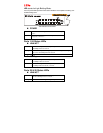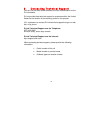5
For Fast Ethernet networks, a switch is an effective way of eliminating
the problem of chaining hubs beyond the “two-repeater limit.” A switch
can be used to split parts of the network into different collision domains,
making it possible to expand your Fast Ethernet network beyond the
205-meter network diameter limit for 100BASE-TX networks. Switches
supporting both traditional 10Mbps Ethernet and 100Mbps Fast Ethernet
are also ideal for bridging between existing 10Mbps networks and new
100Mbps networks.
Switching LAN technology is a marked improvement over the previous
generation of network hubs and bridges, which were characterized by
higher latencies. Routers have also been used to segment local area
networks, but the cost of a router, the setup and maintenance required
make routers relatively impractical. Today switches are an ideal solution
to most kinds of local area network congestion problems.
Features and Benefits
(24) 10/100BASE-TX Fast Ethernet ports + (2) 1000BASE-T
Gigabit Ethernet ports
Auto MDI/MDI-X support on each port
Full/half duplex transfer mode for 10/100Mbps Fast Ethernet
transmission
Full duplex transfer mode for Gigabit Ethernet transmission
Wire-speed reception and transmission
Store-and-Forward switching method
Integrated address Look-Up Engine, supports 8K MAC
addresses
Supports 512K bytes RAM for data buffering
Extensive front-panel diagnostic LEDs
Broadcast storm protection
IEEE 802.3x flow control for full-duplex
Back pressure flow control for half-duplex
Standard 19” Rack-mount size


















